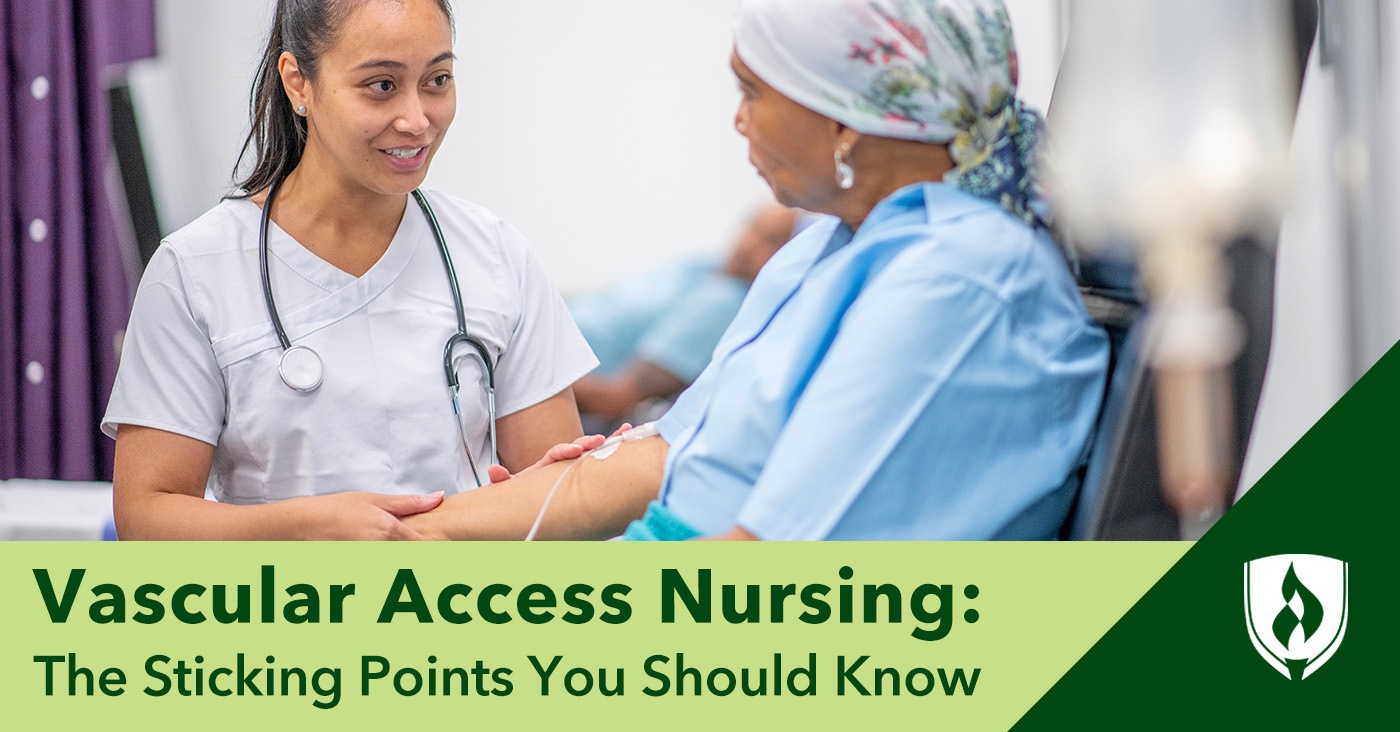
Most of us dread the thought of needles and IVs at the doctor’s office. However, if you’ve had a nurse who managed to do the job in one stick or have had the unfortunate experience of being poked several times in one visit, you know what a difference a well-trained nurse can make.
When you’ve had an IV or watched a patient on a medical drama wince through one, did you know that some nurses can focus their careers specifically on this critical skill? These nurses—vascular access nurses—have experience and often special training to make this situation and other, more advanced, techniques as painless as possible.
What is vascular access nursing? What training do these nurses have? Keep reading to learn more about this nursing specialty that isn’t for the faint of heart.
What are vascular access nurses?
As the job title suggests, vascular access nurses are focused on the tasks and skills needed for accessing a patient’s veins. That might sound simple, but there’s a lot that this entails.
These nurses start IVs as well as other difficult-to-initiate lines like peripherally inserted central catheters (PICCs) and central venous catheters (CVCs). And if a patient leaving the facility needs to have one of these lines, the vascular access nurse teaches the patient how to take care of the line at home, including the precautions to take to help prevent infection.
Through all these tasks, vascular access nurses work with doctors who tell the nurse what type of line to insert. They may also work with the radiology department to confirm the line’s placement. And obviously, they interact directly with patients when inserting lines.
You’ll find these nurses doing their job usually in hospitals, as well as surgery centers, long-term care facilities or units in nursing homes.
While this job has some similarities to IV or infusion nurses, vascular access nurses are responsible for setting up the IV line, while IV or infusion nurses are only responsible for giving a patient the medication or infusions that they need via an IV or other vascular access port.
Vascular access nurse training
What qualifications or certifications do vascular access nurses need?
The most important qualification a vascular access nurse needs is a Bachelor of Science in Nursing (BSN) degree or an Associate’s degree in Nursing (ADN). While there are differences, both of these programs will prepare you for the world of nursing and position you to become a registered nurse (RN).
Additional professional certifications like being a Certified Registered Nurse Infusion (CRNI®) or having a Vascular Access Board Certification (VA-BC®) can set you apart and show that you’ve gone the extra mile toward this job. While these are recommendations or preferences for some jobs, other employers may require these qualifications.
Beyond certifications, having experience working with IVs and other types of vascular access is important for this career. Clinical experience in a nursing program can obviously teach you a lot about this and give you hands-on knowledge. Beyond clinicals, though, there are plenty of ways to add further experience to your resume, like working as a phlebotomist, and seeking out opportunities in units that regularly use IVs, PICC lines and CVCs—so intensive care, oncology and emergency units are all solid options for building experience.
What is a PICC RN?
Another job that has significant overlap with vascular access nursing is being a PICC RN. These nurses have special training to insert PICC lines into patients. As they only work with a particular type of vascular access, PICC RNs have a more specialized job than vascular access nurses. That said, vascular access nurses also insert PICC lines as part of their job.
PICC nurses—and vascular access nurses—are responsible for putting in PICC lines, which start in a vein in the patient’s arm and run through the patient’s vascular system all the way to near the patient’s heart.
These nurses have the important job of allowing the doctor to access these veins near a patient’s heart. PICC lines are used to deliver medication or nutrients as well as to draw blood (or deliver blood) if one is already inserted, and they can prevent a nurse from having to repeatedly stick a patient with needles elsewhere. These lines are often used for cancer patients, patients with digestive issues and patients with infections.
What are some of the challenges of vascular access nursing?
One obvious challenge of this job is the need to be comfortable working with needles and blood. If you’re a bit squeamish, not good around needles or afraid of blood, then this might not be the area of nursing for you. If this is you, check out our article “Medical Jobs Without Blood: A Beginner’s Guide.”
Similarly, many patients also share those fears, so the best vascular access nurses are able to comfort their patients through these procedures. Whether it’s chatting with a patient to distract them or waiting for the patient to relax, having a calming, caring demeanor and positive attitude is critical for this job.
Finally, vascular access nurses are often called on to help with patients who may present significant challenges, and getting a line properly set up can be quite difficult. Finding and accessing a vein isn’t always easy and can take several tries, much to the discomfort of the patient. Even the best vascular access nurses sometimes have to make multiple attempts. The key here is to remain sympathetic with the patient and get the job done in as few stabs as possible.
Another challenge outside of the scope of direct patient care is that this specialized role isn’t present in all facilities. While there may be exceptions, typically only larger hospitals and health systems have the resources (and consistent patient need) to keep a dedicated group of vascular access specialists on staff.
What’s rewarding about vascular access nursing?
If you’re comfortable with the needles in this job, vascular access nursing can actually be incredibly rewarding.
Being able to work hands-on with patients means you get to watch as the medications you’re delivering save lives. You are witness to the tangible results of patients’ healing and eventually checking out to go home.
Another aspect of the hands-on work in this job is informing patients how to take care of certain lines when they go home. If you like to teach others, then this can be incredibly fulfilling.
And every patient appreciates a nurse who understands their fear of needles. If you can get a patient on the first poke or chat with them to soothe their nerves, you can rest assured that they are grateful beyond measure.
Finally, this may be a bit odd for some, but getting a vein on the first poke or successfully inserting a line can be extremely rewarding—particularly if you’re called in by other nursing units to help with a tricky case. There’s a sense of pride that comes with being able to perfectly execute a task that requires specialized skill.
Is vascular access nursing the career for you?
Now that you know more about vascular access nursing, you know how important this job is—and what a difference an excellent vascular access nurse can make in a patient’s life.
If this job makes you feel a little squeamish, that’s okay. Having needles, IVs and complex lines be the central focus of your job is not for everybody. However, there are dozens of other nursing careers that could be the perfect fit. Read our article “Top 25 Types of Nurses Employers Are Looking to Hire” to find out about the most in-demand nursing jobs.
Do you have a heart for healthcare and a stomach of steel? If needles don’t phase you, you may have exactly what it takes to be a vascular access nurse. Your first step toward this career is getting the crucial registered nurse (RN) credential. Check out our article “How to Become an RN Fast: 3 Potential Paths to Pursue” to find out how you can launch your career ASAP.
CRNI is a registered trademark of Infusion Nurses Certification Corporation.
VA-BC is a registered trademark of Josephine Brandon




